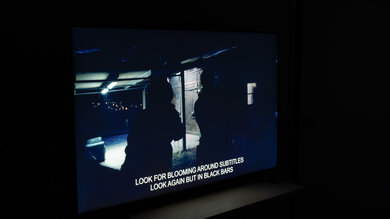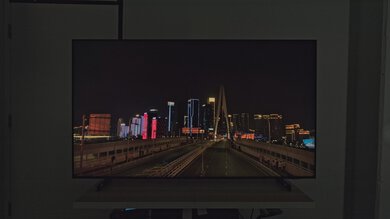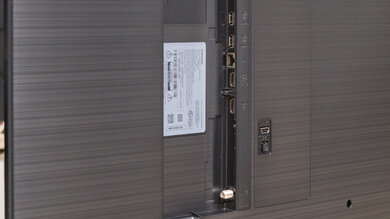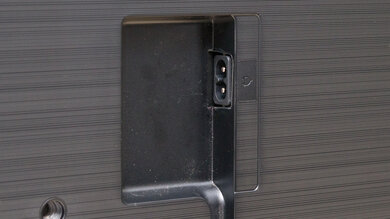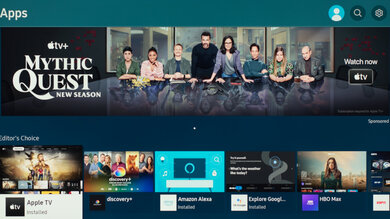The Samsung AU8000 is one of the entry-level models in Samsung's 2021 lineup, replacing the Samsung TU8000. It's the only TV in the Crystal UHD lineup in North America, but in Europe, it sits between the AU7000 and AU9000 models. It competes with other entry-level models like the Sony X80J, LG UP8000, and Hisense A6G. It's a simple model that lacks features like variable refresh rate (VRR) and HDMI 2.1 support. It runs a simplified version of Samsung's 2021 Tizen OS smart interface, which offers most of the same features as more advanced models but has fewer animations to keep the interface running smoothly. It comes with the same great remote as more expensive models, and it even supports voice controls to make it easy to find your favorite content.
Our Verdict
The Samsung AU8000 is an okay TV overall. It's best suited for watching shows or sports in a moderately lit room as it can handle some glare due to its great reflection handling. It's a decent TV for gaming thanks to its low input lag, but it has no advanced gaming features, and its slow response time means there is noticeable motion blur with fast-moving objects. The TV displays a wide color gamut that displays vibrant colors with HDR content, but it doesn't get bright enough to make highlights stand out, so HDR content has little impact. Due to the TV's lower contrast ratio and lack of local dimming, blacks aren't very deep and have a cloudiness to them. Unfortunately, it has a narrow viewing angle, so it's not a good choice for a wide seating arrangement, as the image degrades when viewed at an angle.
- Great reflection handling.
- Low input lag in and outside of Game Mode.
- Lacks a local dimming feature.
- Doesn't get very bright in SDR or HDR.
- Slow response time that makes motion look blurry.
The Samsung AU8000 is decent for watching TV shows. Although it doesn't get very bright, it still has great reflection handling, meaning visibility won't be an issue in a moderately lit room. It doesn't have upscaling issues with lower-resolution content, so it's a good choice for watching shows from cable boxes or DVDs. Sadly, it has a narrow viewing angle, so it's not ideal if you like to move around your room while watching TV or have a wide seating arrangement, as the image degrades when viewed from the side.
- Great reflection handling.
- Upscales lower-resolution content without issues.
- Narrow viewing angle.
- Doesn't get very bright in SDR or HDR.
The Samsung AU8000 is decent for watching sports. It has great reflection handling, so it can handle some glare in a moderately-lit room, but bright lights or windows are still distracting. Unfortunately, it has a slow response time, so fast-moving action in sports looks blurry. Also, it has a narrow viewing angle, so it's not ideal for watching the big game with a group of friends, as anyone not seated directly in front of the TV has to view a degraded image.
- Great reflection handling.
- Upscales lower-resolution content without issues.
- Narrow viewing angle.
- Doesn't get very bright in SDR or HDR.
- Slow response time that makes motion look blurry.
The Samsung AU8000 is decent for gaming. It has low input lag for a responsive gaming experience, so there's very little delay between your controller inputs and the action on-screen. However, it has a slow response time that makes faster-moving motion look blurry. The TV supports Auto Low Latency Mode (ALLM) that switches your TV into game mode when launching a game, but it doesn't support any advanced gaming features like variable refresh rate and is limited to HDMI 2.0 bandwidth. Unfortunately, the TV doesn't support 1440p @ 60Hz.
- Great reflection handling.
- Low input lag in and outside of Game Mode.
- Slow response time that makes motion look blurry.
- Limited to 60Hz and no VRR support.
- No 1440p @ 60Hz support.
The Samsung AU8000 is okay for watching movies in a dark room. It has excellent black uniformity, and there's no distracting blooming around bright areas, but since the TV has a low native contrast ratio and lacks a local dimming feature, blacks aren't very deep. The TV supports a wide color gamut, which results in vibrant colors when watching HDR content, but it doesn't get bright enough for highlights to stand out the way they should. It supports HDR10 and HDR10+ but lacks Dolby Vision, which is unfortunate since a lot of 4k Blu-rays and streaming services use the format.
- Removes judder from 24p sources.
- Lacks a local dimming feature.
- Doesn't get very bright in SDR or HDR.
The Samsung AU8000 is decent for HDR gaming. It has low input lag, so there is very little delay between your controller inputs and the actions on the screen. However, it has a slow response time, so there's noticeable blur with quick-moving objects, and due to the lack of VRR, you'll have screen-tearing. The TV can display a wide color gamut, so colors are vibrant when gaming in HDR. Unfortunately, it has bad HDR brightness when in 'Game' mode, so highlights don't stand out. It also has a low native contrast ratio and lacks a local dimming feature, so blacks aren't deep. Sadly, there is no 1440p @ 60Hz support.
- Low input lag in and outside of Game Mode.
- Doesn't get very bright in SDR or HDR.
- Slow response time that makes motion look blurry.
- No 1440p @ 60Hz support.
The Samsung AU8000 is decent for use as a PC monitor. It has low input lag for a responsive desktop experience, making your mouse movements smooth. However, due to the TV's slow response time, there's noticeable motion blur with quick-moving objects. It has great reflection handling, so glare isn't an issue in a moderately-lit room. It also displays chroma 4:4:4 properly, which is essential for clear text from a PC. Unfortunately, the TV has a narrow viewing angle, so the image looks washed-out at the sides if you sit too close to the screen, and it doesn't support 1440p @ 60Hz.
- Great reflection handling.
- Low input lag in and outside of Game Mode.
- Displays chroma 4:4:4.
- Narrow viewing angle.
- No 1440p @ 60Hz support.
Changelog
- Updated Jul 26, 2024: Added additional information to the Accelerated Longevity Test from the findings on our edge-lit TV investigation.
- Updated Jun 11, 2024: Unfortunately, this TV died as part of an in-depth investigation into edge-lit TVs. It has been removed from the Accelerated Longevity Test.
- Updated Mar 27, 2024: Unfortunately, the backlight on our unit has failed. We've started looking into it, and we'll post updates in the Accelerated Longevity Test section of the review.
- Updated Feb 13, 2024: We uploaded the latest brightness measurements and uniformity photos for the Accelerated Longevity Test.
Check Price
Differences Between Sizes And Variants
We bought and tested the 65-inch Samsung AU8000, and the results are also valid for the 43-inch, 50-inch, 55-inch, 70-inch, 75-inch, and 85-inch models as well, but the 70-inch model isn't available in North America. The warehouse variant is known as the Samsung AU800D. The 43-inch model has an IPS panel in some regions, so it has a wider viewing angle but worse contrast.
| Size | US Model | Short Model Code |
|---|---|---|
| 43" | UN43AU8000FXZA | UN43AU8000 |
| 50" | UN50AU8000FXZA | UN50AU8000 |
| 55" | UN55AU8000FXZA | UN55AU8000 |
| 65" | UN65AU8000FXZA | UN65AU8000 |
| 70" | - | UN70AU8000 |
| 75" | UN75AU8000FXZA | UN75AU8000 |
| 85" | UN85AU8000FXZA | UN85AU8000 |
Our unit was manufactured in April 2021; you can see the label here.
Popular TV Comparisons
The Samsung AU8000 is a basic entry-level 4k TV with decent overall performance. It's a nice improvement from the Samsung TU8000, and although it doesn't get as bright as the higher-end Samsung Q60/Q60A QLED, it offers better value for the dollar.
See our recommendations for the best budget TVs, the best 4k TVs, and the best 40-42-43 inch TVs.
The Samsung AU8000 and the Samsung CU7000/CU7000D are very similar TVs. Both TVs are limited to 4k @ 60Hz, but the CU7000 is slightly better for gaming, as it has a faster response time and the ability to play games in 1440p. The AU8000 is better for use in a bright room due to its better reflection handling and slightly better SDR brightness, so it overcomes a bit more glare than the CU7000.
The Samsung AU8000 is a bit better overall than the Samsung TU7000. They have similar features, but the AU8000 is better in a few areas. The AU8000 gets brighter and has better reflection handling, so it's a better choice for well-lit rooms. It also has an upgraded version of Tizen OS, which feels smoother to use, and it comes with a mic for voice control in the remote, which the TU7000 doesn't have. On the other hand, the TU7000 supports 1440p, which the TU8000 doesn't.
The Samsung CU8000 is slightly worse than the Samsung AU8000. The CU8000 is better in a few areas, as it has a wider color gamut, better color volume, higher HDR brightness in game mode, and much better low-quality content smoothing. The AU8000, however, has much better reflection handling, better build quality, much better color accuracy both pre- and post-calibration, and is easier to calibrate. It also has much better black uniformity, but this can vary between units. The newer CU8000 does have an upgraded version of Tizen OS, which now supports MultiView on this TV.
The Samsung AU8000 and the LG UQ75 are similar TVs, but the Samsung is better in most situations. The Samsung looks better in a dark room thanks to its better contrast and black uniformity. The Samsung also has a higher SDR peak brightness, so it overcomes glare better in a bright room. Both TVs lack modern gaming features, but the Samsung has a faster response time, so there is less blur with quick-moving objects in games. The LG does have a wider viewing angle, so it’s a bit better if you regularly watch TV in a group setting, as anyone watching from the side won't have to deal with a significantly degraded image like on the Samsung.

We buy and test dozens of TVs yearly, taking an objective, data-driven approach to deliver results you can trust. Our testing process is complex, with hundreds of individual tests that take over a week to complete. Most of our tests are done with specially designed test patterns that mimic real content, but we also use the same sources you have at home to ensure our results match the real-world experience. We use two main tools for our testing: a Colorimetry Research CR-100 colorimeter and a CR-250 spectroradiometer.
Test Results

The TV has a surprisingly premium design for an entry-level model. It comes with new feet compared to 2020's Samsung TU8000, and they sit flat against the table. It has thin bezels all around and looks nice in any setup.
After 14 months on our accelerated longevity test, the Samsung AU8000 has developed multiple serious issues and has been removed from the test. Multiple LEDs have failed, causing backlight uniformity issues. The standoffs that normally support the light guide plate (LGP) also melted from the heat of the LEDs, causing the LGP to slide down. The heat from the LEDs this close to the LGP caused cracks and visible lines in the display. The reflector sheet is also warped, causing the Rorschach-like patterns on the screen.
As part of our two-year test, which has so far subjected 100 TVs to over 10,000 hours of accelerated testing, we found that edge-lit TVs like this one have significant durability issues. These issues range from warped reflector sheets and cracked light guide plates to completely burnt-out LEDs. You can read the full results of our investigation here.
The stand consists of two plastic feet that support the TV well. You can customize the feet to place the TV in a higher vertical position (in photo) to place a soundbar in front without blocking the screen, or it can be placed closer to the table as seen here.
Footprint of the 55-inch stand: 42.6" x 11.1". The height of the lower position is 1.78", and the higher one is 3.08".
The back of the TV has similar etched horizontal lines as other Samsung TVs. It doesn't offer much in terms of cable management, but you can run cables through the clips in the feet and the tracks in the back panel. The ports all face to the side, but because they're placed inside a cutout on the back, they're nearly impossible to access when the TV is wall-mounted, so a mounting arm that pulls out from the wall is recommended.
This TV doesn't have a local dimming feature; the entire backlight is always on at the same intensity, so there's no distracting flicker or brightness changes as bright highlights move across the screen.
The HDR brightness is poor. It's not bright enough to display HDR content properly, and small bright highlights in dark scenes are dimmed considerably by the TV's frame dimming feature.
These measurements are after calibrating the HDR white point with the following settings:
- HDR Picture Mode: Movie
- Brightness: Max
- Contrast: Max
Unfortunately, the TV is significantly dimmer in the 'Game' HDR Picture Mode.
These measurements are after calibrating the HDR white point, with the following settings:
- HDR Picture Mode: Game
- Color Gamut: Auto
- Color Temperature: Warm 2
- Brightness: Max
- Contrast: Max
This TV has great PQ EOTF tracking, ensuring that most HDR content is displayed at the correct brightness level. Like most TVs with no local dimming, near-blacks are raised a bit. Midtones are also slightly too bright, but it's very close overall. There's a very smooth roll-off near the TV's peak brightness, so fine details in bright scenes are preserved.
The SDR brightness is okay. It's bright enough to overcome glare in a moderately lit room, and there's no noticeable variation in brightness with different content. Unfortunately, when gaming in SDR in the 'Game' Picture Mode, very small highlights in near-black scenes are dimmed considerably, flashing briefly at 145 nits before dropping to 104. This is extremely rare in most games.
These measurements are after calibration with the following settings:
- Picture Mode: Movie
- Brightness: Max
- Contrast: Default
- Gamma: 2.2
The Samsung AU8000 has a decent HDR color gamut, with very good coverage of the DCI P3 color space. This results in vibrant colors when watching most HDR content, but it can't display the full range of colors available, so some content can look dull and muted. It has very limited coverage of the wider Rec. 2020 color space that is increasing in popularity, so it's not very future-proof.
Due to the narrow color gamut, the color volume is sub-par. It displays darker colors fairly well but struggles more with brighter colors.
With just a few quick settings changes out-of-the-box, the Samsung AU8000's accuracy before calibration is good. Most colors are slightly inaccurate, but reds, yellows, and cyans are the most off. The white balance is okay, but brighter shades of gray are a bit off. The color temperature is near the 6500K target, and gamma follows the 2.2 target very well.
The accuracy after calibration is fantastic. Any remaining inaccuracies to the white balance and most colors are almost impossible to notice, except for saturated reds, which are a bit off. The color temperature is also closer to the calibration target of 6500K. It's very easy to calibrate, and it features a full-color calibration system, which is uncommon for entry-level TVs.
You can see our full calibration settings here.
The Samsung AU8000 has a narrow viewing angle. Colors start to shift, and the image looks darker as you move off-center, so it's not ideal for a wide seating area or if you like to move around your room with the TV on.
The gradient handling is excellent, which is a significant improvement from the Samsung TU8000. There's a bit more banding in the reds and greens, but it's not too noticeable. The Noise Reduction setting, which is designed to smooth out gradients in low-quality content, doesn't appear to do anything at all.
The panel is different from the Samsung TU8000 and looks like an MVA panel, which is a type of VA panel and performs the same. There's dithering with blue pixels, but it's only visible with a full white screen. It has BGR subpixel layout, which negatively affects text clarity when using it as a PC monitor.
The Samsung AU8000 has an okay response time. Transitions in dark scenes are very slow, resulting in a long trail behind dark objects, known as black smearing. Motion looks blurry because of this slower response time, and there are noticeable duplications due to the TV's backlight flicker.
The Samsung AU8000 uses pulse width modulation (PWM) to dim its backlight, which results in flicker that can cause headaches and eye strain. It's flicker-free in the 'Movie' Picture Mode with the Brightness set to anything '25' and above, but it flickers at 480Hz at '24' and below. It flickers at 120Hz with Picture Clarity enabled or in Game Mode. It also flickers at 120Hz in the 'Dynamic', 'Standard', and 'Natural' Picture Modes, but it's flicker-free in those modes if the backlight is set to its max.
The Samsung AU8000 has a backlight strobing feature, commonly known as black frame insertion (BFI). BFI is designed to improve the appearance of motion by reducing the amount of persistent blur. It flickers at 60Hz outside of Game Mode if you enable LED Clear Motion, but once Game Mode is enabled, there aren't any motion settings and it always flickers at 120Hz, which leads to motion duplication. Unfortunately, the flicker introduced is poorly timed, resulting in noticeable crosstalk, so the overall usefulness of this feature is limited.
The Samsung AU8000 has the option to interpolate 30fps content up to 60fps, which gives motion the 'Soap Opera Effect'. It looks okay in slower scenes but stops interpolating altogether during busy scenes, which is distracting due to the sudden change in frame rate.
Since the TV has a slower response time, there's very little stutter when watching low frame rate content, like movies.
Like the Samsung TU8000, this TV can only remove judder from sources that can send a true 24p signal, like a Blu-ray player or a streaming box with a "match frame-rate" feature. It can't remove judder from sources that don't have this feature, like most cable boxes.
This TV has a basic 60Hz panel without any variable refresh rate support. If you want a budget-friendly TV with VRR support, check out the Vizio M6 Series Quantum 2022.
This TV has incredibly low input lag as long as Game Mode is enabled. Surprisingly, input lag is still low enough for most casual gamers even outside of Game Mode.
The Samsung AU8000 supports most common resolutions, but only at 60Hz, as it doesn't support a 120Hz refresh rate. Chroma 4:4:4 is displayed properly when the TV is set to 'PC' mode, which is important for clear text from a computer.
Since it's a 60Hz TV, it only supports 4k games up to 60fps from the PS5. It has an Auto Low Latency Mode that automatically switches the TV into Game Mode to get the lowest input lag possible when a game is launched.
Since it's a 60Hz TV, it only supports 4k games up to 60fps from the Xbox Series S|X. It has an Auto Low Latency Mode that automatically switches the TV into Game Mode to get the lowest input lag possible when a game is launched. Unfortunately, the TV doesn't support Dolby Vision.
Unlike the Samsung TU8000, the Samsung AU8000 has no component or composite inputs. You'll need an external HDMI adapter to connect older devices like retro game consoles.
Even though the Samsung AU8000 doesn't have HDMI 2.1 bandwidth inputs, it still supports eARC. This allows you to pass uncompressed audio in the Dolby Atmos via TrueHD format to a compatible receiver over a single HDMI connection. It can also pass through a DTS 5.1 signal through ARC, which is great, although it can't do the same through optical, nor does it support advanced DTS formats through eARC.
The frequency response is mediocre. It doesn't produce much bass, and there are compression artifacts at its max volume. You have to listen at moderate levels if you want a more well-balanced sound profile.
The distortion performance is mediocre. Although there isn't too much at moderate listening levels, it increases quite a bit at its max volume.
The Samsung AU8000 comes with an upgraded version of Tizen compared to 2020's Samsung TU8000; the menu navigation feels smoother, and it's easy to use. However, it has fewer features than some higher-end models like the Samsung Q80/Q80A QLED as it lacks things like MultiView.
This TV comes with the same new redesigned remote as other Samsung TVs in 2021, except it requires disposable batteries instead of a rechargeable one. There are shortcut buttons to popular streaming devices, and the voice control gives you access to Bixby, Alexa, and Google Assistant. You can ask it to change settings and switch inputs, but you can't ask it to search for specific content in apps.









